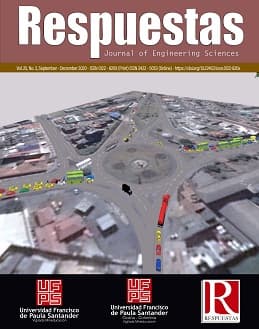Analysis and assessment of the terrain instability in urbanization projects. A case study in Tijuana, Mexico
Análisis y evaluación del riesgo por inestabilidad del terreno en proyectos de urbanización. Un estudio de caso en Tijuana, México
Main Article Content
This article explains aspects related to the risk produced by the terrain instability and its components (hazard and vulnerability), different methods to estimate it, its main conditioning and triggering factors, and the close link with urbanization processes in areas of rugged topography and complex geological - geotechnical conditions. A procedure is described that allows analyze and assessment this risk in urbanization projects, as an essential tool for making decisions about its feasibility and viability; and the results of its application in a case study in the metropolitan area of Tijuana, Mexico, are presented.
Downloads
Article Details
A.O. Oliva-González, A.F. Ruiz-Pozo, R.J. Gallardo-Amaya, H.J. Jaramillo, “Landslide risk assessment in slopes and hillsides. Methodology and application in a real case”. DYNA, 86(208), pp. 143-152. 2019. http://doi.org/10.15446/dyna.v86n208.72341
O.A. Cuanalo, A.O. Oliva, R. J. Gallardo, “Inestabilidad de laderas. Procesos Constructivos de Estabilización”. Editorial Académica Española, p, Alemania. 2012.
P. N. Angarita, R. J. Gallardo, A. O. Oliva, “Analysis of urban vulnerability before natural and anthropogenic hazards: Case study, human settlement Colinas de la provincia, municipality of Ocaña, Colombia”. Journal of Physics: Conference Series; 1257: pp. 1–7. 2019.
C.J. Van Westen et al., “Multi-hazard risk assessment distance education course. Guide book”. United Nations University – ITC School on Disaster Geoinformation, p 371. 2011.
A.O. Oliva, “Evaluación del riesgo por deslizamientos de laderas en zonas urbanas: Estudio de casos en la ciudad de Tijuana, México (Spanish Edition). Editorial Académica Española, p108, Letonia. 2018.
O.A. Cuanalo, A.O. Oliva, y C. González, “Estabilidad de laderas. Análisis mediante factores de valuación”, Revista IngeoPress, No. 164., Spain, pp. 38-44. 2007.
M. Uzielli, F. Nadim, S. Lacasse, and A.M. Kaynia, “A conceptual framework for quantitative estimation of physical vulnerability to landslides”, Engineering Geology, 102(3), pp 251-256. 2008. https://doi.org/10.1016/j.enggeo.2008.03.011
Z. Li, F. Nadim, H. Huang, M. Uzielli, and S. Lacasse, “Quantitative vulnerability estimation for scenario-based landslide hazards”, Landslides 7: pp. 125-134. 2010. https://doi.org/10.1007/s10346-009-0190-3
G.E. Ávila et al., “Guía metodológica para estudios de amenaza, vulnerabilidad y riesgo por movimientos en masa”. Colección Guías y Manuales. Servicio Geológico Colombiano. Colombia, p182. 2016.
F. Huang, K. Yin, J. Huang, L. Gui, P. Wang, “Landslide susceptibility mapping based on self-organizing-map network and extreme learning machine”. Eng Geol 223: pp. 11–22. 2017. https://doi.org/10.1016/j.enggeo.2017.04.013
A. Shirzadi, D.T. Bui, B.T. Pham, K. Solaimani, K. Chapi, A. Kavian, H. Shahabi, I. Revhaug, “Shallow landslide susceptibility assessment using a novel hybrid intelligence approach”. Environ Earth Sci 76: p1515. 2017. https://doi.org/10.1007/s12665-016-6374-y
P. Reichenbach, M. Rossi, B.D. Malamud, M. Mihir, F. Guzzetti, “A review of statistically based landslide susceptibility models”. Earth Sci Rev. 180: pp. 60–91. 2018. https://doi.org/10.1016/j.earscirev.2018.03.001
B.T. Pham, A. Jaafari, I. Prakash, D.T. Bui, “A novel hybrid intelligent model of support vector machines and the MultiBoost ensemble for landslide susceptibility modelling”. Bull Eng Geol Environ 78: pp. 2865–2886. 2019. http://doi-org-443.webvpn.fjmu.edu.cn/10.1007/s10064-018-1281-y
S. Segoni, G. Pappafico, T. Luti, et al., “Landslide susceptibility assessment in complex geological settings: sensitivity to geological information and insights on its parameterization”. Landslides. 2020. https://doi.org/10.1007/s10346-019-01340-2
A.O. Oliva, “Riesgos en Proyectos de Ingeniería del Sector de la Construcción. Causas y Efectos”, presented at 4to Encuentro Internacional de Ciencias Aplicadas e Ingeniería (Universidad – Industria), Cúcuta, NS, Colombia. 2018.
E. Mansilla e I. Rubio, “Diagnóstico nacional de los asentamientos humanos ante el riesgo de desastres”. Secretaría de Desarrollo Social (SEDESOL), México. p128. 2011.
A.O. Oliva et al., “Urban development and human activity as factors in terrain instability in Tijuana”. Engineering Failure Analysis; 19: pp. 51–62. 2012. https://doi.org/10.1016/j.engfailanal.2011.09.005
A.O. Oliva et al., “Terrain instability in the Tijuana metropolitan area: Analysis of a failure in the access road to a industrial park”. Engineering Failure Analysis; 104: pp. 354–370. 2019. https://doi.org/10.1016/j.engfailanal.2019.05.040
SLOPE/W, “Stability Modelling with SLOPE. An Engineering Methodology”. GEO_SLOPE International Ltd, Alberta, Canada, p244. 2012.
SIGMA/W, “Stress – Strain Modelling with SIGMA. An Engineering Methodology”. GEO_SLOPE International Ltd, Alberta, Canada, p212. 2012.




 Perfil Google Scholar
Perfil Google Scholar



